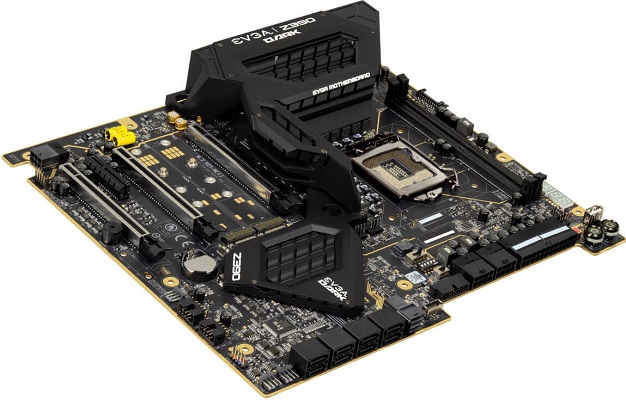EVGA's Powerful Z390 Dark Enthusiast Motherboard Embraces The Dark Side Of The Force
The board has several overclocking features including two external clock generators. A clock generator is essentially a clock or a metronome that sets a steady pace inside of the PC, and this rate is typically expressed as a base clock or the FSB clock. By increasing the base clock speed, the clock speed of the CPU is also increased and performance is elevated. This is an unpopular method of overclocking nowadays, as many other components such as the system memory and PCI-E controllers also derive their clock speed from the base clock.

By utilizing multiple separate clock generators, this problem is lessened and it becomes possible to overclock the CPU further by raising its base clock without causing other components to become unstable. EVGA dedicates one of the external clock generators placed on the Z390 Dark exclusively to the CPU cores, and the second clock generator is devoted PCI-E controller.
EVGA also has you covered if you accidentally push the system too far and make it unstable. The board has three BIOS ROMs that are selected by a switch. A USB port set on the corner of the motherboard can be used to flash a new BIOS image to any of these ROMs even if you don't have a CPU set in the system. An unusual feature of the board is what EVGA calls a SW Slow Mode switch, which will lock the CPU to operate at its minimum idle clock speed. This will help to ensure stability and give the processor a chance to cool down between benchmarks, making it an excellent tool for overclockers.

Using these overclocking features, professional overclocker Luumi was able push an Intel Core i9-9900K CPU up to 6,987MHz, which produced a score of 3,142 on Cinebench R15.
The motherboard also supports memory up to 4,600MHz, but in a somewhat unusual move EVGA just placed two DIMM slots on the motherboard. As a result, the board's maximum memory capacity is capped at 32GB.
EVGA added support for a wide range of storage devices on its Z390 Dark. The motherboard supports a total of eight SATA-III ports, six of which are connected to the motherboard's Z390 chipset, whereas the other two are powered by an ASMedia ASM1061 controller. There are two M.2 Key M ports for ultra fast storage devices and an M.2 Key E slot for either an additional storage device or a Wi-Fi chip. There aren't a lot of U.2 devices on the market, but EVGA included U.2 port as well for good measure.
The Z390 Dark also features a Creative audio codec and a Creative Core3D quad-core audio processor to produce high-end audio. EVGA's new NU Audio technology is used in conjunction with a headphone amplifier to help drive audio performance over the front panel audio connector.

EVGA also teased its Kingpin GeForce RTX 2080 graphics card along-side this motherboard, but there is still no information about this card available. You can see the card in the photo above seated inside of the Z390 Dark motherboard. With so many features, it should come as no surprise that EVGA's Z390 Dark carries a fairly hefty price tag of $499.99. You can purchase the board now directly from EVGA.

